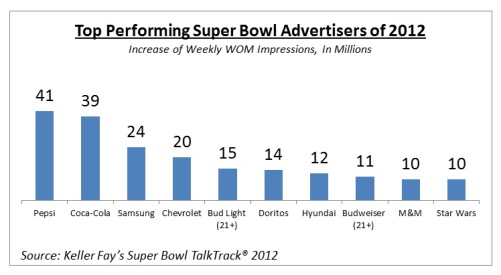For Super Bowl Advertisers, the Biggest Buzz Comes via the Water Cooler, Not Twitter. - Ed Keller

The teams for the Super Bowl are now set. Callers to sports radio shows and pundits on cable TV will debate who has the better chance to win and why.
At the same time, the marketing pundits are gearing up to assess who will get the most bang for the $4 million being invested for each 30 second spot. It used to be the winner of the USA Today Ad Meter was the arbiter they used to assess who "won" and who "lost" the advertising wars. Now, however, conventional wisdom is that we can judge success via monitoring twitter and other online social media.
Consider these data and comments from last year's postmortem, as an example. "The numbers are in and this year's Super Bowl generated record-breaking numbers in social media comments." The same article talked about a "firestorm of Twitter and Facebook activity" based on a reported 600% growth in social media comments over the year prior.
When I hear about 600% growth, I immediately assume whatever is being measured must be starting from a low base, because it's much easier to grow small numbers six fold than big numbers. And indeed that is the case with social media and the Super Bowl. What was the total number of comments on social media last year? The Super Bowl as a whole drew 12.2 million social media comments, of which fewer than 1 million comments -- 985,000 to be exact -- were about the commercials.
So that's "the firestorm" – a total of 985,000 comments about Super Bowl advertisers, a minute fraction of the estimated 111 million actual viewers. The big winner in social media – an ad for H&M featuring a bare-chested David Beckham – drew a total of 109,000 comments. The "Halftime in America" ad from Chrysler placed second, followed by a promo for NBC's "The Voice", a Doritos ad, and in fifth place was Pepsi, with its "King's Court" ad featuring Elton John and X-Factor winner Melanie Amaro which garnered 45,000 social media comments.
Contrast those numbers with these. When we consider all word of mouth – conversations at Super Bowl parties, at the water cooler the next day and the days after that, as well as social media – the number of word of mouth impressions about Super Bowl advertisers increased by 236 million over the level of conversation these same advertisers enjoyed in the one month period prior to the Super Bowl. This comes from the annual Super Bowl TalkTrack® study conducted by my firm, and represents about two conversations about the advertisers per viewer.
The big winner in terms of total word of mouth was Pepsi, which saw its word of mouth spike by more than 41 million. 41 incremental million WOM impressions vs. 45 thousand social media posts – you tell me which is the firestorm!
Here is a list of the other high performing advertisers:

H&M, which captured more social media posts than any other advertiser, was one of the worst performing advertisers of any we measured with word of mouth levels actually lower in the week after the Super Bowl than in the month prior. Did H&M win the social media battle but lose the much bigger word of mouth war? Was the online conversation more about David Beckham's tattoos and pecs than about the advertised brand, H&M?
Last year's Super Bowl comes on the heels of a highly successful Super Bowl XLVI, both in terms of the outcome (yes, I'm a Giants fan) and the volume of conversation about the ads. Here are a few additional statistics:
- In total, the advertisers saw their word of mouth rise a collective 26%, higher than in any of the previous five Super Bowls we have measured.
- These conversations don't just happen the day of, or even the Monday after. They remain at elevated levels for the three days following the game.
- Word of mouth rose at a similar rate for both men and women, which is one of the keys to why this game, with its huge, dual audience is such a bonanza for word of mouth.
- Most of the talk about advertised brands was positive.
- Nearly half of consumers listening to a conversation about a Super Bowl advertiser (47%) said they were highly likely to buy the brand. This very high level of intent to purchase is consistent with what we see for word of mouth generally, and the reason word of mouth is so highly prized.
Engaging brands are like engaging people—we naturally want to invite them into our conversations and into our living rooms. Getting a hundred thousand people to post comments about your brand in social media is nice, but the real winners at Super Bowl LVXII will be those advertisers that ignite and sustain the much bigger prize of real world conversation. And lest we forget, getting invited into consumer conversation should not be a goal just once a year for Super Bowl advertisers, but for all advertisers, all year long.
May the best team – and the best advertisers – win.
Ed Keller, CEO of the Keller Fay Group, has been called "one of the most recognized names in word of mouth." His new book, The Face-to-Face Book: Why Real Relationships Rule in a Digital Marketplace, was recently published by Free Press/Simon & Schuster. You can follow Ed Keller on Twitter, Facebook and Google+, or contact him directly at ekeller@kellerfay.com.
Read all Ed’s MediaBizBloggers commentaries at WOM Matters.
Check us out on Facebook at MediaBizBloggers.com
Follow our Twitter updates @MediaBizBlogger
The opinions and points of view expressed in this commentary are exclusively the views of the author and do not necessarily represent the views of MediaBizBloggers.com management or associated bloggers. MediaBizBloggers is an open thought leadership platform and readers may share their comments and opinions in response to all commentaries.


